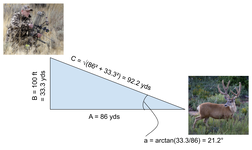muleyapprentice
FNG
- Joined
- Jan 7, 2024
- Messages
- 36
I shot a buck yesterday and want to know the non angle compensated range. It was 86 yards with 100 feet elevation loss. Is there a formula for this? Is it rangefinder specific? I’m guessing I could take the approximate slope of the hill, but once I know what the angle of the shot was now what?

